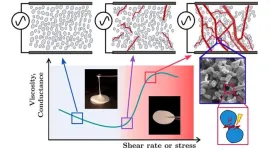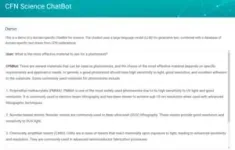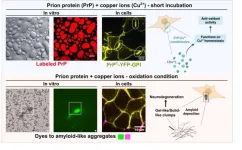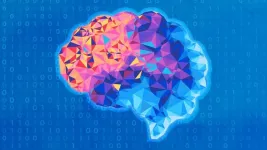(Press-News.org) If you mix cornstarch and water in the right proportions, you get something that seems not-quite-liquid but also not-quite-solid. Oobleck flows and settles like a liquid when untouched, but stiffens when you try to pick it up or stir it with a spoon. The properties of oobleck and other non-Newtonian fluids — including Silly Putty, quicksand, paint, and yogurt — change under stress or pressure and scientists have long struggled to prove exactly why.
Now, researchers at the University of Chicago’s Pritzker School of Molecular Engineering (PME) have used piezoelectric nanoparticles, which themselves change in response to pressure, to investigate the fundamental physics of non-Newtonian fluids. The team discovered a key role for friction between particles in causing the materials to flip from a fluid to a more solid structure.
“This not only answers long-standing basic questions about the physical origins of these materials, but opens up doors for the design of new non-Newtonian fluids with practical applications,” said Stuart Rowan, the Barry L. MacLean Professor of Molecular Engineering and co-senior author of the paper, published in Proceedings of the National Academy of Sciences.
Among those potential applications: paint that doesn’t clump, liquids that harden into a mold when shaken, and wearable protective gear that stiffens when hit.
Piezoelectric probes
A hallmark of non-Newtonian fluids is that their viscosity — how thick they are — changes dramatically when the materials are under stress. For some materials, this means thinning with stress. Shaking a ketchup bottle can make the condiment drastically more pourable; yogurt, mayonnaise and toothpaste maintain their shape in a container yet become more liquid-like upon use.
But other materials like oobleck, which is a concentrated particle suspension, behave just the opposite: it can feel solid while being manipulated yet collapse into a puddle when placed down.
Scientists have formulated hypotheses about why concentrated particle suspensions change when sheared — being exposed to multiple forces acting in different directions. These hypotheses mostly relate to how the molecules and particles that make up the materials can interact with each other in different ways under different conditions — but each hypothesis is hard to prove.
“To understand these concentrated particle suspensions, we want to be able to look at the nanoscale structure, but the particles are so incredibly crowded together that imaging these structures is very hard,” explained postdoctoral scholar Hojin Kim, the first author of the new paper.
To overcome this challenge, Kim collaborated with Rowan, Aaron Esser-Kahn, also a professor in the PME and an expert in piezochemistry, and Heinrich Jaeger, the Sewell Avery Distinguished Service Professor of Physics. The team developed a technique that measures the change in electrical conductance based on the shear force exerted upon it. Then, they suspended the nanoparticle in a liquid at such a concentration that it exhibited non-Newtonian properties in the same way as oobleck.
The researchers applied shear force to the top and bottom of the liquid and simultaneously measured the resulting changes to both viscosity and the electrical signals. That let them determine how the particles were interacting as they changed from a more liquid to more solid-like material.
“We found that friction between particles was critical to this transition,” said Kim. “In this concentrated particle solution, there is a tipping point when the friction reaches a certain level and the viscosity abruptly increases.”
A range of applications
Understanding the physical forces at play in a concentrated particle solution is one step toward being able to design new non-Newtonian fluids in the lab. One day, these engineered materials could have customized properties that let scientists control their viscosity through stress. In some instances, this could translate to less clumping and clogging of liquids like paint and concrete. In other cases, it might mean a purposeful hardening of materials when desired.
“For any application, we hope we can eventually determine the ideal combination of solvents and particles and shear conditions to get the properties we want,” said Kim. “This paper might seem like very fundamental research but in reality, non-Newtonian fluids are everywhere and so this has a lot of applications.”
For now, the Pritzker Molecular Engineering and UChicago researchers are planning to take advantage of the stress-induced piezoelectric activity of their nanoparticle suspensions to design new adaptive and responsive materials that, for example, become stiffer under mechanical force.
Citation: “Stress-Activated Friction in Sheared Suspensions Probed with Piezoelectric Nanoparticles,” Kim et al, PNAS, November 28, 2023. DOI: https://doi.org/10.1073/pnas.2310088120
Funding: UChicago Materials Research Science and Engineering Center (MRSEC) funded by the National Science Foundation, Army Research Laboratory
END
New understanding of oobleck-like fluids contributes to smart material design
UChicago Pritzker Molecular Engineering research on the science behind non-Newtonian fluids - which change viscosity under under stress among other properties - could lead to applications ranging from clump-free paint to wearable protective gear
2023-12-01
ELSE PRESS RELEASES FROM THIS DATE:
Brainstorming with a bot
2023-12-01
A researcher has just finished writing a scientific paper. She knows her work could benefit from another perspective. Did she overlook something? Or perhaps there's an application of her research she hadn't thought of. A second set of eyes would be great, but even the friendliest of collaborators might not be able to spare the time to read all the required background publications to catch up.
Kevin Yager—leader of the electronic nanomaterials group at the Center for Functional Nanomaterials (CFN), a U.S. Department of Energy (DOE) Office of Science User Facility ...
Hip hop dancing promotes awareness of disability rights and performance equality, study shows
2023-12-01
Hip hop dancing can be used to spread awareness of disability rights and help those with sight problems to participate in performance equally, a new study says.
Breakin’ – which is commonly referred to as breakdancing - is good for mobility and helps promote balance and stability as well as wellbeing.
It also offers an important opportunity for people to slow down and to connect with their inner selves, their feelings, their bodies, and their peers, according to researchers. It has been used to treat symptoms of depression, anxiety and PTSD.
Nathan Geering, ...
Urgent work needed to tackle “substantial” digital health inequality, study recommends
2023-12-01
Millions of people are suffering from digital health inequality because of poverty, experts have warned.
A new study says urgent work is needed to ensure those from deprived areas can access healthcare as the NHS increasingly turns to the use of apps and online health portals for the provision of healthcare.
A team of doctors and academics found a “significant association” between increased poverty and reduced use of digital services. Their modelling estimates that this association accounts for 4.27million patients across England who have not downloaded the NHS app. In October 2022 it was estimated more than 37million patients had activated ...
Unlocking the secret strength of marine mussels
2023-12-01
How do you create strong, yet quick-release connections between living and non-living tissues? This is a question that continues to puzzle bioengineers who aim to create materials that bond together for advanced biomedical applications.
Looking to nature for inspiration, the McGill-led research zeroed in on the marine mussel byssus, a fibrous holdfast, which these bivalve mollusks use to anchor themselves in seashore habitats. The byssus attaches to rocky surfaces using an underwater glue, but the other end (the byssus stem root) is firmly anchored within the mussel’s soft living tissue. This area of contact between the living ...
When physics meets biology: prion protein orchestrates liquid-liquid phase separation with copper
2023-12-01
In a groundbreaking study published in Science Advances, researchers from the Federal University of Rio de Janeiro (UFRJ) and the German Center for Neurodegenerative Diseases (DZNE-Berlin) shed light on the intricate dance between the prion protein and copper ions in the physiopathology of live cells. The research paves the way for potential treatments addressing copper-bound prion protein clusters to prevent abnormal solid formation and mitigate neurodegenerative outcomes.
Like oil droplets in water, cells harbor membrane-bound organelles that ...
Eminent scientists say a child-centric approach is the blueprint to improve communities
2023-12-01
Communities can prosper by providing attentive education and social services to their youngest residents — but the challenge is for leaders to work together.
That is the message of Craig Ramey and Sharon Ramey, Virginia Tech distinguished research professors of the Fralin Biomedical Research Institute at VTC, who today (Dec. 1, 2023) presented details of a decades-long study that focuses on early childhood education and development.
In a research article in the journal Medical Research Archives, the official journal of the European Society of Medicine, the scientists discuss lessons ...
Adverse childhood experiences linked to muscle dysmorphia
2023-12-01
Toronto, ON – A new study published in Clinical Social Work Journal found that adolescents and young adults who experienced adverse childhood experiences (ACEs) before the age of 18 were significantly more likely to experience symptoms of muscle dysmorphia.
With previous research showing that more than half of North American children and adolescents experience at least one adverse childhood experience in their lifetime, these new findings highlight the need for greater awareness of how adverse experiences in childhood (such as domestic violence, emotional abuse, and sexual abuse) and muscle dysmorphia (the pathological ...
New health problems emerge after COVID-19 for those who lack quality housing, health care
2023-12-01
New research from the Texas A&M University School of Public Health suggests that those who live with ongoing poverty and poor housing conditions are more likely to develop new mobility issues following a COVID-19 infection.
This study, published in Preventive Medicine, is the first to examine the relationship between social vulnerability and persistent COVID-19 symptoms. In it, researchers analyzed data about socially vulnerable Michigan residents who experienced new difficulty in walking or climbing stairs after ...
Two leading standards bodies launch Neuroscience Community, powering a global data network that will speed up answers in autism, Parkinson’s, addiction, and more
2023-12-01
The Global Alliance for Genomics and Health (GA4GH) and the International Neuroinformatics Coordinating Facility (INCF) launched a new group to lay the groundwork for connecting global neuroscience and genomic data.
Answering data-driven questions in neuroscience means dealing with complexity: in types of data, data management systems, the number and variety of conditions, ethical and legal requirements, and the genetic and biological conditions themselves. Even just aligning industry standards for neuroimaging and genomics can be a struggle.
To improve life for people with neurological conditions, we need to tackle the complexity together.
The new GA4GH & INCF Neuroscience ...
Novel screening tool and recovery program may help reduce mental health problems after trauma
2023-12-01
Key takeaways
A new mental health screening tool accurately predicts mental health outcomes for hospitalized trauma patients.
To be sustainable, mental health screening and recovery programs should be tailored to each trauma center, with the engagement of all stakeholders, a related study finds.
Studies shed light on the need for trauma centers to provide injured patients with mental health resources, such as online education, support, and referrals to mental healthcare providers when needed.
CHICAGO (December 1, 2023): A novel screening ...
LAST 30 PRESS RELEASES:
Evidence of cross-regional marine plastic pollution in green sea turtles
Patients with clonal hematopoiesis have increased heart disease risk following cancer treatment
Stem cell therapy for stroke shows how cells find their way in the brain
Environment: Up to 4,700 tonnes of litter flows down the Rhine each year
Maternal vaccine receipt and infant hospital and emergency visits for influenza and pertussis
Interim safety of RSVpreF vaccination during pregnancy
Stem cell engineering breakthrough paves way for next-generation living drugs
California grants $7.4 million to advance gene-edited stem cell therapy for Friedreich’s ataxia
Victoria’s Secret grant backs cutting-edge ovarian cancer research
Research paves the way for safer colonoscopy bowel prep for people with compromised gut health
JMIR Publications and Sweden's National Library announce renewal and expansion of flat-fee unlimited open access partnership for 2026
A new 3D-printed solar cell that’s transparent and color-tunable
IV iron is the cost-effective treatment for women with iron deficiency anemia and heavy menstrual bleeding
Doing good pays off: Environmentally and socially responsible companies drive value and market efficiency
City of Hope and Cellares to automate manufacturing of solid tumor CAR T cell therapy
Short-circuiting pancreatic cancer
Groundbreaking mapping: how many ghost particles all the Milky Way’s stars send towards Earth
JBNU researchers propose hierarchical porous copper nanosheet-based triboelectric nanogenerators
A high-protein diet can defeat cholera infection
A more accurate way of calculating the value of a healthy year of life
What causes some people’s gut microbes to produce high alcohol levels?
Global study reveals widespread burning of plastic for heating and cooking
MIT study shows pills that communicate from the stomach could improve medication adherence
Searching for the centromere: diversity in pathways key for cell division
Behind nature’s blueprints
Researchers search for why some people’s gut microbes produce high alcohol levels
Researchers find promising new way to boost the immune response to cancer
Coffee as a staining agent substitute in electron microscopy
Revealing the diversity of olfactory receptors in hagfish and its implications for early vertebrate evolution
Development of an ultrasonic sensor capable of cuffless, non-invasive blood pressure measurement
[Press-News.org] New understanding of oobleck-like fluids contributes to smart material designUChicago Pritzker Molecular Engineering research on the science behind non-Newtonian fluids - which change viscosity under under stress among other properties - could lead to applications ranging from clump-free paint to wearable protective gear





